How the Russian fleet destroyed the Turkish squadron in the Battle of Sinop
Emperor Nicholas I
"The extermination of the Turkish fleet in Sinop squadron, consisting under my command, can not leave a glorious page in the history of the Black Sea Fleet."
P. S. Nakhimov
December 1 is the Day of Russian Military Glory. This is the victory day of the Russian squadron under the command of Vice-Admiral Pavel Stepanovich Nakhimov over the Turkish squadron at Cape Sinop.
The battle took place in the harbor of Sinop on the Turkish Black Sea coast 18 (30) November 1853. The Turkish squadron was defeated within a few hours. The battle at Cape Sinop was one of the major battles of the Crimean (Eastern) War, which began as a conflict between Russia and Turkey. In addition, it went down in history as the last major battle of sailing fleets. Russia gained a significant advantage over the armed forces of the Ottoman Empire and domination of the Black Sea (before the intervention of the great Western powers).
This naval battle was an example of the brilliant preparation of the Black Sea Fleet, led by one of the best representatives of the school of Russian military art. Sinop struck the whole of Europe with the perfection of the Russian fleet, fully justified the many years of stubborn educational work of admirals Lazarev and Nakhimov.
A.P. Bogolyubov. The extermination of the Turkish fleet in the Battle of Sinop
prehistory
In 1853, the next war between Russia and Turkey began. It led to a global conflict involving the leading world powers. Anglo-French squadron entered the Dardanelles. Fronts were opened on the Danube and Transcaucasia. Petersburg, which was counting on a quick victory over Porto, a decisive advancement of Russian interests in the Balkans and a successful solution to the problem of the Bosphorus and Dardanelles, received the threat of war with great powers, with dim prospects. There was a threat that the Ottomans, and behind them the British and French, would be able to render effective assistance to the highlanders of Shamil. This led to a new large-scale war in the Caucasus and a serious threat to Russia from the south.
In the Caucasus, Russia did not have enough troops to simultaneously deter the advance of the Turkish army and fight the highlanders. In addition, the Turkish squadron supplied troops on the Caucasian coast weapons and ammunition. Therefore, the Black Sea Fleet received two main tasks: 1) in a hurry to transport reinforcements from the Crimea to the Caucasus; 2) strike at the enemy’s maritime communications. Do not allow the Ottomans to land a large landing on the east coast of the Black Sea in the area of Sukhum-Kale (Sukhumi) and Poti to help the highlanders. Both tasks Pavel Stepanovich fulfilled.
September 13 in Sevastopol received an emergency order to transfer to Anakria (Anaklia) infantry division with artillery. At the Black Sea Fleet at that time was restless. There were rumors about the performance on the side of the Ottomans of the Anglo-French squadron. Nakhimov immediately took over the operation. For four days I prepared the ships and deployed the troops in full order: the 16 battalions with two batteries (more than 16 thousand people), and all the necessary weapons and property. September 17 squadron went to sea, and in the morning September September, 24 came to Anacria. By evening, the unloading was completed. The operation was recognized to be brilliant; there were only a few patients among the sailors of the bi-soldiers.
Having solved the first problem, Pavel Stepanovich proceeded to the second. It was necessary to disrupt the enemy landing operation. In Batumi, 20 was concentrated in a thousand Turkish corps, which was supposed to transfer a large transport fleet (up to 250 ships). The landing of the landing was supposed to cover the Osman Pasha squadron.
At this time, the commander of the Crimean army and the Black Sea Fleet was Prince Alexander Menshikov. He sent in search of the enemy squadron Nakhimov and Kornilov. 5 (17) November V. Kornilov met the Ottoman 10-gun ship “Pervaz-Bahre”, which was coming from Sinop. Steamer frigate "Vladimir" (11 cannons) under the flag of the chief of staff of the Black Sea Fleet Kornilov attacked the enemy. Directly the battle led by the commander of "Vladimir" captain-lieutenant Grigory Butakov. He used the high maneuverability of his ship and noticed the weakness of the enemy - the absence of guns at the stern of the Turkish steamer. The whole battle tried to keep so as not to fall under the fire of the Ottomans. The three-hour battle ended with a Russian victory. It was the first in the history of the battle of steam ships. Then Vladimir Kornilov returned to Sevastopol and ordered Rear Admiral F. M. Novosilsky to find Nakhimov and reinforce him with the battleship Rostislav and Svyatoslav, and the brig Eney. Novosilsky met with Nakhimov and, having completed the assignment, returned to Sevastopol.
From the end of October, Nakhimov and a detachment cruised between Sukhum and part of the Anatolian coast, where the main port was Sinop. After the meeting with Novosiltsev, the vice-admiral had five 84-gun ships: "Empress Maria", "Chesma", "Rostislav", "Svyatoslav" and "The Brave", as well as the frigate "Kovarna" and brig "Eney". 2 (14) November Nakhimov issued an order for the squadron, where he notified the commanders that in the event of a meeting with an enemy, "superior to us, I attack him, being absolutely sure that each of us will do his job."
Every day, waiting for the appearance of the enemy. In addition, there was the possibility of meeting with British ships. But there was no Ottoman squadron. Met only Novosilsky, who led the two ships, replacing the battered storm and sent to Sevastopol. On November 8, a cruel storm broke out, and the Vice Admiral was forced to send another 4 ship for repair. The situation was critical. The strong wind continued after the November 8 storm.
On November 11, Nakhimov approached Sinop and immediately sent the brig with the news that there was an Ottoman squadron in the bay. Despite the significant enemy forces that were under the protection of coastal batteries 6, Nakhimov decided to block Sinop Bay and wait for reinforcements. He asked Menshikov to send the ships Svyatoslav and the Brave sent for repairs, the frigate Kovarny and the steamer Bessarabia. The admiral also expressed bewilderment as to why he was not sent a frigate “Kulevchi”, which is idle in Sevastopol, and to send two more additional steamships necessary for cruising. Nakhimov was ready to fight if the Turks went on a breakthrough. However, the Turkish command, although at that time had the advantage in strength, did not dare to enter a general battle or simply go for a breakthrough. When Nakhimov reported that the forces of the Ottomans in Sinop, according to his observations, were higher than previously thought, Menshikov sent reinforcements — the squadron of Novosilsky, and then the detachment of steamboats Kornilov.
Battle of the steamer-frigate "Vladimir" with the Turkish-Egyptian military steamer "Pervaz-Bahri" 5 on November 1853. A.P. Bogolyubov
The forces of the parties
The reinforcements arrived on time. 16 (28) November 1853, the Nakhimov detachment reinforced the squadron of Rear Admiral Fyodor Novosilsky: 120-gun battleship Paris, Grand Duke Constantine and Three Saints, frigates Kagul and Kulevchi. As a result, under the authority of Nakhimov there were already 6 battleships: the 84-gun "Empress Maria", "Chesma" and "Rostislav", the 120-gun "Paris", "Grand Prince Konstantin" and "Three Saints", 60-gun frigate " Kulevchi ”and 44-gun“ Cahul ”. The guns of Nakhimov was 716, from each side of the squadron could give a volley of weight in 378 pounds 13 pounds. 76 guns were bombing, firing explosive bombs, which had great destructive power. Thus, on the side of the Russian fleet was an advantage. In addition, Kornilov was in a hurry to help Nakhimov with three steam-powered frigates.
The Turkish squadron consisted of: there were 7 frigates, 3 corvette, several auxiliary vessels and a detachment of 3 steam frigates. In general, the Turks had 476 naval guns, backed by 44 coastal guns. The Ottoman squadron was led by the Turkish Vice-Admiral Osman Pasha. The second flagship was Rear Admiral Hussein Pasha. When the squadron was English adviser - Captain A. Slade. The detachment of steamboats commanded by Vice Admiral Mustafa Pasha. The Turks had their advantages, the main of which were parking in a fortified base and the presence of steamers, while the Russians had only sailing ships.
Admiral Osman Pasha, knowing that the Russian squadron was guarding him at the exit from the bay, sent a disturbing message to Istanbul, asked for help, greatly exaggerating Nakhimov's forces. However, the Turks were late, the message was transmitted to the British 17 (29) in November, one day before the attack of the Russian fleet. Even if Lord Stratford-Radcliffe, who at that time was actually in charge of Porta’s policy, ordered the British squadron to go to the aid of Osman Pasha, it would still be late. Besides, the English ambassador in Istanbul had no right to start a war with the Russian Empire, the admiral could refuse.
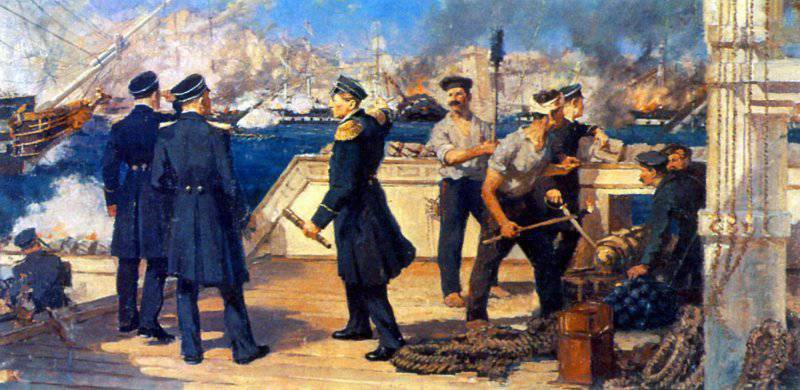
N.P. Medovikov. P.S. Nakhimov during the Sinop battle of 18 in November 1853
The idea of Nakhimov
The Russian admiral, as soon as the reinforcements arrived, decided not to wait, immediately enter Sinop Bay and attack the enemy. In essence, Nakhimov was taking a risk, albeit well calculated. The Ottomans had good ship and coastal guns, and with proper leadership, the Turkish forces could inflict serious damage on the Russian squadron. However, the once formidable Ottoman fleet was in decline, both in terms of combat training and leadership.
The Turkish command itself played along with Nakhimov, placing the ships extremely inconvenient for defense. First, the Ottoman squadron was located like a fan, a concave arc. As a result, the ships closed the shelling sector of part of the coastal batteries. Secondly, the ships were located along the embankment, which prevented them from maneuvering and firing with two sides. Thus, the Turkish squadron and coastal batteries could not fully resist the Russian fleet.
Nakhimov's plan was imbued with determination and initiative. The Russian squadron in the ranks of two wake columns (the ships followed one after another along the course line) was ordered to break through the Sinop raid and inflict a fire strike on the enemy’s ships and batteries. The first column commanded Nakhimov. It included the ships "Empress Maria" (flagship), "Grand Duke Constantine" and "Chesma." The second column was led by Novosilsky. It included "Paris" (2-th flagship), "Three Saints" and "Rostislav." The movement of the two columns was to reduce the time of passage of ships under the fire of the Turkish squadron and coastal batteries. In addition, facilitated the deployment of Russian ships in combat order when anchored. In the rearguard were frigates that were supposed to stop the enemy's attempts to escape. The targets of all the ships were distributed in advance.
At the same time, the commanders of the ships had a certain independence in the choice of targets, depending on the specific situation, while fulfilling the principle of mutual support. “In conclusion, I will express the idea,” wrote in the order of Nakhimov, “that all the preliminary instructions under the changed circumstances may make it difficult for a commander who knows his business, and therefore I give everyone a completely independent way to act at their discretion, but certainly to do their duty.”
Battle
At dawn 18 (30) November, Russian ships entered Sinop Bay. At the head of the right column was the flagship of Pavel Nakhimov "Empress Maria", at the head of the left - "Paris" of Fyodor Novosilsky. The weather was unfavorable. In 12 hours 30 minutes Ottoman flagship 44-gun "Avni-Allah" opened fire, followed by firing guns of other ships and coastal batteries. The Turkish command hoped that a strong barrage of ship and coastal batteries would not allow the Russian squadron to break through at close range, causing the Russians to retreat. May lead to severe damage to some ships that can be captured. The ship Nakhimov led the way and closest to the Ottoman ships. The admiral stood on the captain's cabin and watched a violent artillery battle unfolding.
The victory of the Russian fleet was identified in two hours and a little. The Turkish artillery, bombarded the Russian squadron with shells, was able to cause significant damage to some ships, but was unable to sink any. The Russian admiral, knowing the techniques of the Ottoman commanders, foresaw that the main enemy fire would initially focus on the mast (the deck parts of the ship equipment), and not the decks. The Turks wanted to disable as many Russian sailors as possible when they would remove the sails before putting the ships on anchor, and also to break the controllability of the ships, to impair their ability to maneuver. And so it happened, the Turkish shells broke yards, cusps, and sails. The Russian flagship took over a significant part of the enemy strike, most of its spars and standing rigging were smashed, only one guy remained untouched by the mainmast. After the battle, 60 holes were counted in one side. However, the Russian sailors were down, Pavel Stepanovich ordered the ships to be anchored without removing the sail armament. All orders Nakhimov were executed in accuracy. The frigate “Avni-Allah” (“Aunni-Allah”) did not withstand the confrontation with the Russian flagship and in half an hour rushed ashore. Turkish squadron lost control center. Then the "Empress Maria" fell asleep with shells 44-gun frigate "Fazli-Allah", which also could not stand the duel and rushed to the shore. The admiral transferred the fire of the battleship to the battery number XXUMX.
I. K. Aivazovsky. "Sinop fight"
The ship "Grand Prince Konstantin" fired at the 60-gun frigates "Forever-Bahri" and "Nesimi-Zefer", 24-gun corvette "Nedzhmi Fishan", the battery number 4. “Navek-Bahri” went off the air within 20 minutes. One of the Russian shells hit the powder magazine. This explosion has disabled the battery number XXUMX. The corpses and wreckage of the vessel cluttered the battery. Later, the battery resumed fire, but it was weaker than before. The second frigate, after he had broken the anchor chain, brought to shore. Turkish corvette could not stand the duel and rushed to the shore. "Grand Duke Constantine" in the Battle of Sinop received 4 holes and damage to all masts.
The battleship Chesma, under the command of Viktor Mikryukov, fired on batteries No. XXUMX and No. XXUMX. Russian sailors clearly followed the instructions of Nakhimov about mutual support. The ship "Konstantin" was forced to fight immediately with three enemy ships and a Turkish battery. Therefore, the Chesma ceased firing at the batteries and concentrated all the fire on the Turkish frigate Navek-Bahri. The Turkish ship, hit by the fire of two Russian ships, blew up. Then "Chesma" put down the enemy batteries. The ship received 4 holes, damage to the mainmast and bowsprit.
In the same position, when the principle of mutual support was fulfilled, the ship "Three Saints" was half an hour later. The battleship under the command of K.S. Kutrov fought with the Qaedi-Sefer 54-gun frigate and the Nizamiy 62-gun. Enemy shots from the Russian ship interrupted the spring (the cable to the anchor holding the ship in a predetermined position), the Three Saints began to roll down the stern to the enemy. The ship has undergone the longitudinal fire of the battery №6, its mast seriously suffered. Immediately, Rostislav, under the command of the captain of the 1 rank A.D. Kuznetsov, who himself was subjected to heavy shelling, stopped return fire and concentrated all his attention on the battery No.6. As a result, the Turkish battery was demolished. "Rostislav" also forced to throw themselves on the shore 24-cannon corvette "Feise-Meabud." When Midshipman Varnitsky was able to repair the damage on the "Saint", the ship began to successfully fire at the "Qaedi-Sefer" and other ships, forcing them to be thrown onto the shore. The Three Prelates received 48 holes, as well as damage to the stern, all the masts and bowsprit. Help wasn’t cheap either for the Rostislav, the ship almost blew up, a fire started on it, the fire was getting close to the camera, but the fire was eliminated. Rostislav received 25 holes, as well as damage to all masts and bowsprit. More than 100 people from his team were injured.
The second Russian flagship Paris led an artillery duel with the 56-cannon frigate Damiad, the 22-cannon corvette Gyuli Sefid and the central coastal battery No. XXUMX. Corvette caught fire and flew into the air. The battleship focused fire on the frigate. "Damiad" could not stand the strong fire, the Turkish team chopped off the anchor line, and the frigate threw ashore. Then "Paris" was attacked by 5-gun "Nizamiye", on which Admiral Hussein Pasha held the flag. The Ottoman ship lost two masts - fok- and mizzen-mast, it started a fire. "Nizamie" rushed to the shore. The commander of the ship Vladimir Istomin in this battle showed "fearlessness and firmness of spirit", made "prudent, skillful and quick orders." After the defeat of "Nizamie" "Paris" focused on the central coastal battery, it had a great opposition to the Russian squadron. Turkish battery was depressed. The battleship received 62 holes, as well as damage to the stern and gondek.
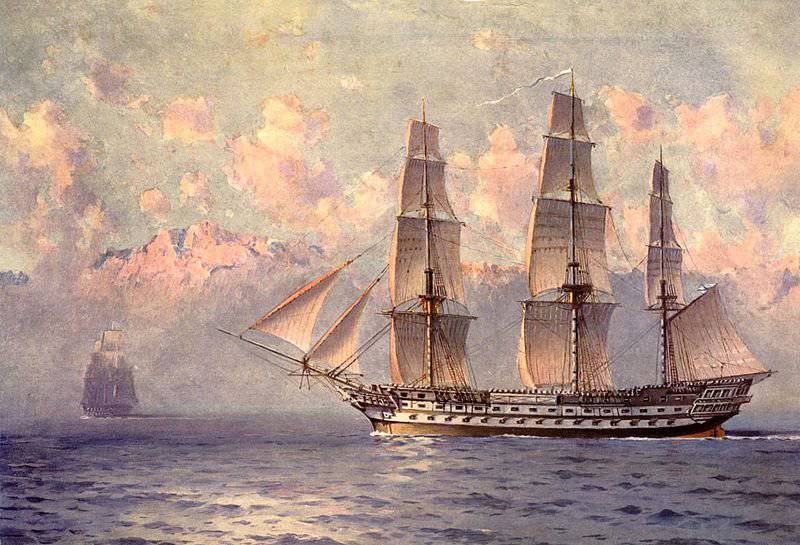
A.V. Ganzen "The linear ship" Empress Maria "under sail"
IK Aivazovsky "120-gun ship" Paris ""
Thus, by 17 hours, the Russian sailors destroyed 15 from the 16 enemy ships, suppressed all its coastal batteries by artillery fire. Random buildings were set on fire and urban buildings that were in close proximity to the coastal batteries, which led to the spread of fire and caused panic among the population.
Of the entire Turkish squadron, only one high-speed 20 cannon steamer Tayf (Taif) escaped with flight, carrying the chief seaman’s advisor on maritime affairs, Englishman Slade, who, arriving in Istanbul, reported on the extermination of Turkish ships in Sinop.
It is worth noting that the presence in the Turkish squadron of two steam-powered frigates seriously puzzled the Russian admiral. Admiral Nakhimov did not have steamboats at the beginning of the battle; they arrived only at the very end of the battle. The high-speed enemy ship, which was under the command of the British captain, could well manifest itself in the battle, when the Russian ships were tied up in battle, and their sail armament was damaged. Sailing ships in these conditions could not easily and quickly maneuver. Nakhimov was so reckless with this threat that he devoted to her a whole point of his disposition (No. 9). Two frigates were left in reserve and were given the task of neutralizing the actions of enemy steam-powered frigates.
However, this reasonable precaution did not materialize. The Russian admiral evaluated the possible actions of the enemy on his own. He was ready to fight even in conditions of complete superiority of the enemy, the enemy commanders thought otherwise. Captain "Taif" Slade was an experienced commander, but he was not going to fight to the last drop of blood. Seeing that the Turkish squadron was facing destruction, the British captain skillfully maneuvered between Rostislav and the battery number XXUMX, and ran towards Constantinople. The Kulevchi and Cahul frigates attempted to intercept the enemy, but they could not keep up with the fast steamer. Breaking away from the Russian frigates "Taif" nearly fell into the hands of Kornilov. A detachment of steam-powered frigates Kornilov hurried to the aid of Nakhimov's squadron and collided with Taif. However, Slade was able to escape from the ships of Kornilov.
By the end of the battle, a detachment of ships under the command of Vice Admiral V. A. Kornilov, who was in a hurry to help Nakhimov from Sevastopol, approached Sinop. B.I. Baryatinsky, a participant in these events, who was in the Kornilov squadron, wrote: “Going up to the ship“ Maria ”(Nakhimov’s flagship), we sit on the boat of our steamer and go to the ship, all pierced with cores, almost all the guys were killed, and The mast's pretty strong ripples swayed so much that they threatened to fall. We climb aboard the ship, and both admirals rush into each other’s arms, we all also congratulate Nakhimov. He was magnificent, his cap on his head, his face was stained with blood, new epaulettes, his nose was all red from blood, the sailors and officers ... all were black from powder smoke ... It turned out that the "Mary" had the most killed and wounded as Nakhimov walked head in the squadron and became from the very beginning of the battle closest to the Turkish firing boards. The coat of Nakhimov, which he took off before the fight and hung right there on the carnation, was torn by the Turkish core. ”
I. K. Aivazovsky. “Sinop. The night after the fight 18 November 1853 of the year "
Results
The Ottoman squadron was almost completely destroyed. During the three-hour battle, the Turks were defeated, their resistance broken. A little later, they suppressed the remaining coastal fortifications and batteries, finished off the remnants of the squadron. One by one Turkish ships flew into the air. Russian bombs fell into the powder cellars, or fire reached them, often the Turks set fire to the ships themselves, leaving them. Three frigates and one corvette were set on fire by the Turks themselves. “The battle is glorious, higher than Chesma and Navarin!” - this is how Vice-Admiral V. A. Kornilov appreciated the battle.
The Turks lost about 3 thousand people, the British reported 4 thousands. Just before the battle, the Ottomans were preparing for boarding and put additional soldiers on ships. The explosions on the batteries, fires and explosions of beached ships led to a strong fire in the city. Sinop was badly hurt. The population, government and garrison of Sinop fled to the mountains. Later, the British accused the Russians of deliberate cruelty towards the townspeople. 200 people got into Russian captivity. Among the prisoners was the commander of the Turkish squadron, Vice-Admiral Osman Pasha (he had his leg broken in battle) and two ship commanders.
Russian ships in four hours fired about 17 thousand shells. The battle of Sinop showed the importance of bombing weapons for the future development of the fleet. Wooden ships could not resist the fire of such guns. It was necessary to develop the armor protection of ships. The highest rate of fire showed gunners "Rostislav". From each gun of the operating side of the battleship 75-100 shots were made. On the other ships of the squadron, 30-70 shots were fired with every weapon on the active side. Russian commanders and sailors, according to Nakhimov, showed "true Russian courage." The advanced system of education of the Russian seaman, developed and implemented by Lazarev and Nakhimov, proved its superiority in battle. Persistent training, sea trips led to the fact that the Black Sea Fleet passed the "Sinop Exam" perfectly.
Some Russian ships received significant damage, then they were towed by steamers, but all remained afloat. Russian casualties amounted to 37 killed and 233 injured. Everyone noted the highest skill of the Russian admiral Pavel Stepanovich Nakhimov, he correctly took into account his forces and the forces of the enemy, went to a reasonable risk, leading a squadron under the fire of coastal batteries and the Omani squadron, worked out a detailed plan for the battle, showed decisiveness in achieving the goal. The absence of dead ships and relatively low losses in manpower confirm the rationality of the decisions and the naval skill of Nakhimov. Nakhimov himself was, as always, modest and said that all the credit belongs to Mikhail Lazarev. The battle of Sinop was a brilliant point in the long history of the development of the sailing fleet. It should be noted that Lazarev, Nakhimov and Kornilov understood this very well, being supporters of the rapid development of the steam fleet.
At the end of the battle, the ships carried out the necessary repairs and 20 November (2 December) was removed from the anchor, moving to Sevastopol. 22 (December 4) Russian fleet with a general glee entered the Sevastopol raid. The entire population of Sevastopol met a victorious squadron. It was a great day. Endless "Hooray, Nakhimov!" Rushed from all sides. The lime, about the crushing victory of the Black Sea Fleet, rushed to the Caucasus, the Danube, Moscow and St. Petersburg. Emperor Nicholas awarded Nakhimov with the Order of St. George 2 degree.
Pavel Stepanovich himself was concerned. Purely the military results of the Battle of Sinop, the Russian admiral was pleased. The Black Sea Fleet brilliantly solved the main task: eliminated the possibility of a Turkish landing on the Caucasian coast and destroyed the Ottoman squadron, winning complete supremacy in the Black Sea. Colossal success was achieved with little blood and material losses. After a hard search, battle and crossing the sea, all the ships successfully returned to Sevastopol. Nakhimov was pleased with the sailors and the commanders, they kept in a hot battle superbly. However, Nakhimov possessed strategic thinking and understood that the main battle is still ahead. Sinop victory will cause the appearance on the Black Sea of the Anglo-French forces, who will use all efforts to destroy the combat-ready Black Sea fleet. The real war has just begun.
The battle of Sinop caused a panic in Constantinople. They were afraid of the appearance of the Russian fleet near the Ottoman capital. In Paris and London, they first tried to belittle and diminish the significance of the feat of the Nakhimov squadron, and then when it became useless, as details of the Sinop battle appeared, envy and hatred arose. As Count Alexei Orlov wrote, “we are not forgiven by either skilful orders or the courage of execution.” In Western Europe, russophobia is rising. Westerners did not expect such brilliant actions by the Russian naval forces. England and France are beginning to take reciprocal steps. The British and French squadrons that were already stationed in the Bosphorus, December 3 sent the steam ship 2 to Sinop and 2 to Varna, for reconnaissance. Paris and London immediately gave Turkey a loan for the war. The Turks have long been unsuccessfully asked for money. Sinop changed everything. France and England were preparing to enter the war, and the Battle of Sinop could force Constantinople to go to an armistice, the Ottomans suffered defeats on land and sea. It was necessary to cheer ally. The Paris largest bank immediately set about organizing the case. The Ottoman Empire was given a loan in 2 million pounds of gold. Moreover, half of the subscription for this amount was to cover Paris, and another London. On the night from 21 to 22 in December 1853 of the year (3-4 in January 1854), the English and French squadrons, together with the Ottoman fleet division, entered the Black Sea.
During the Great Patriotic War 1941-1945. The Soviet government established an order and a medal in honor of Nakhimov. The Order was received by officers of the Navy for outstanding success in developing, conducting and supporting naval operations, as a result of which the enemy’s offensive operation was repulsed or active fleet operations were provided, the enemy suffered considerable damage and maintained his strength. The medal was awarded to sailors and foremen for military merit.
Day of Military Glory of Russia - Victory Day of the Russian squadron under the command of P.C. Nakhimov above the Turkish squadron at Cape Sinop (1853 year) - celebrated in accordance with the Federal Law of March 13 of 1995 of the Year "On the days of military glory (victory days) of Russia."
N.P. Krasovsky. Return to Sevastopol squadron of the Black Sea Fleet after the Battle of Sinop. 1863
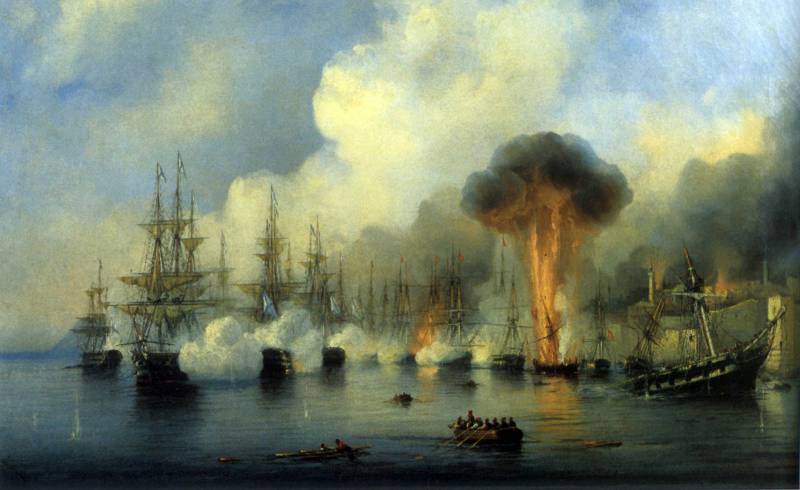
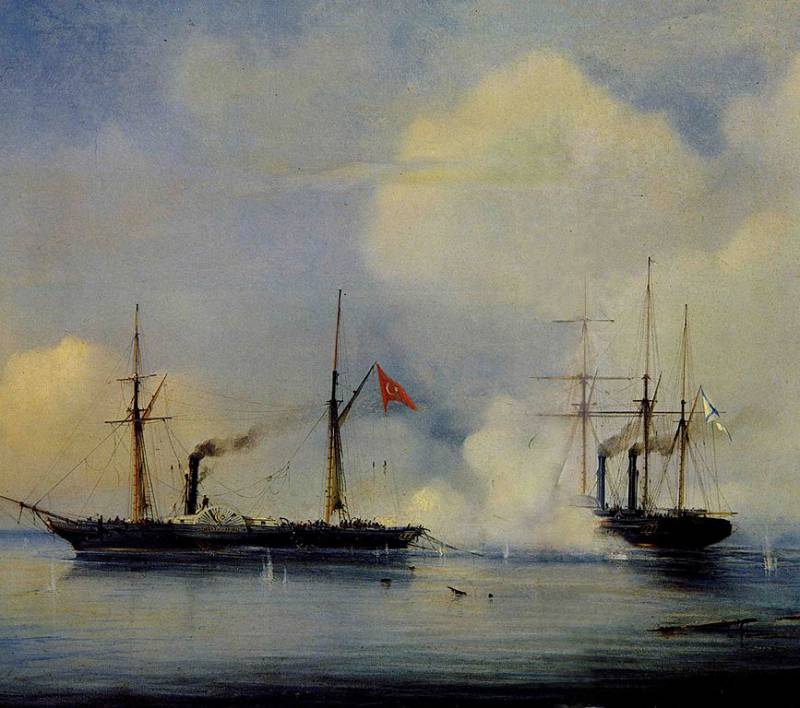
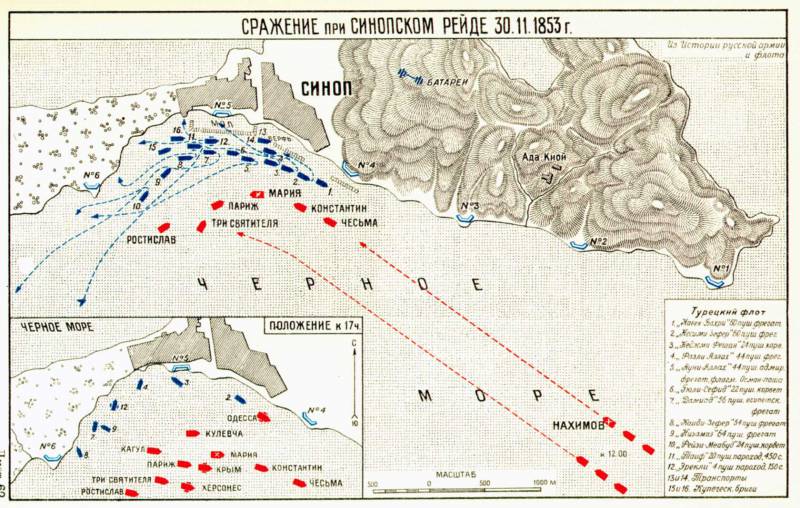
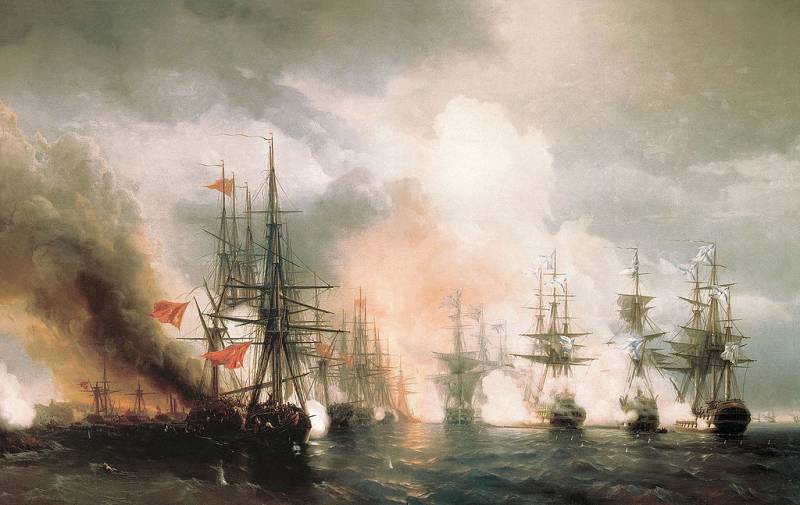
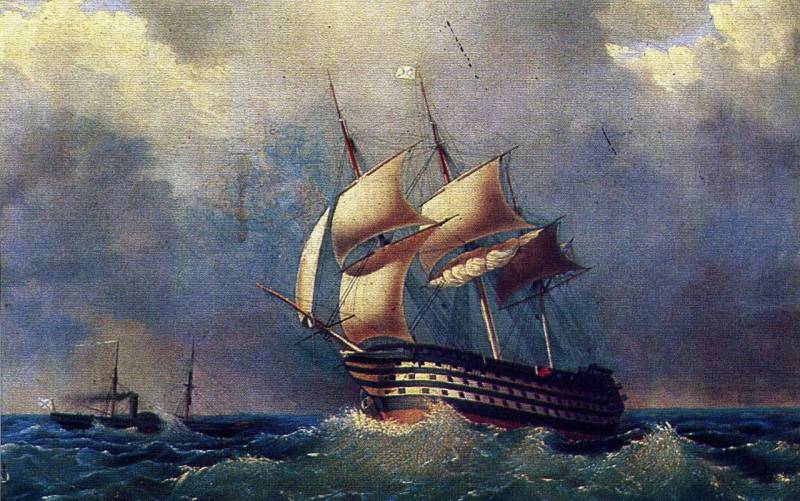
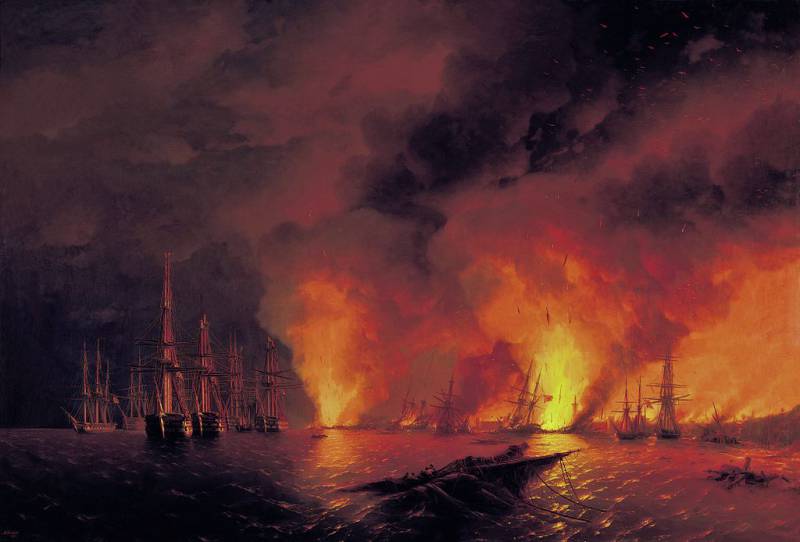
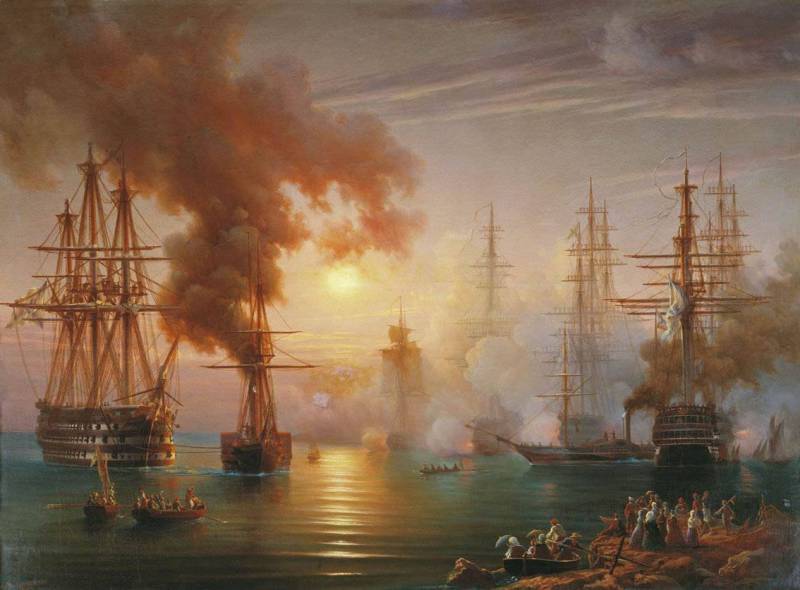
Information